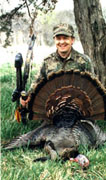Spring Behavior
Copyright © 1998 -
2021
Roger W. Raisch * Nadine Adele, all rights reserved
|
Boiled down to its most basic elements, the life of a wild turkey centers around two activities, survival and
reproduction.
Survival is a constant challenge with two main
components--avoiding predators and securing enough food for growth and maintenance.
Life is fraught with danger for young turkeys.
By the time they have reached adult size in
late fall, they have exceeded the grasp of most potential predators. After that
time, obtaining food to carry them through the winter and to prepare them for the breeding
season is their biggest worry.
The breeding season and the onset of spring
hunting are where it all begins for turkeys and the turkey hunter.
|
The first subtle sign that
spring is approaching appears among wild turkey gobblers as early as mid-February.
On warm, sunny afternoons an occasional gobble
will be heard or toms will be seen strutting in open fields. Hens and toms are still
segregated in separate flocks and will remain this way for weeks.
For the next month or so, gobbling and
strutting and occasional fights slowly increase in frequency, but all activity is centered
around gobbler flocks. Their showing off is not for the benefit of the hens, who
could care less at this point, but solely to impress other toms.
A struggle for dominance is
going on among gobblers to determine which ones will get to do most of the breeding.
|
By late March, if
the weather cooperates, gobbling will be heard every morning and for increasingly longer
periods during the day.
Winter flocks will break up, and for a short
time chaos reigns as hens and gobblers disperse to their spring ranges. Toms travel
in small groups (dominance is already asserted) and are avidly seeking out hens.
At this time, calling
turkeys is easy. Toms are ready to breed, but the hens aren't interested.
Hunters who are out scouting may be convinced that they are the world's greatest turkey
callers. Virtually any kind of call will bring turkeys running.
Unfortunately, things will change rapidly.
|
In early April,
gobbling will be heard on all but the most inclement days and will continue sporadically
all day. Mating flocks of one or two gobblers and several hens develop, but breeding is
still to come.
Hens go to gobblers but are most interested in
feeding. They need the nutrients in newly-emerging green vegetation to build up
their physical condition for egg laying.
Young jakes will be run out of mating flocks
and dominant gobblers will spend most of their day strutting around the hens.
Calling may still be successful.
Toms can sometimes be lured away from
unreceptive hens, and those that don't have hens are still looking.
|
By mid-April (when
most turkey seasons begin) hens become more receptive to the gobbler's advances and visit
him frequently.
Gobbling activity may fall off drastically
except for a brief burst at the roost in early morning and at sunset.
Once the hens have assembled, the gobbler may
quit gobbling for several hours and tend to more serious business.
Hens and gobblers may roost together.
Many toms will simply strut briefly in the
tree until the hens have assembled, fly down to them, and strut away without ever gobbling
again.
During this mid-season lull,
calling turkeys in the early morning can be fruitless. Most of the breeding occurs
now and gobblers are too concerned with the hens they can see to respond to a chance
offering in the brush (you).
|
Many details of the actual mating process
are not known.
Hens have to mate only once to produce a
complete clutch of fertile eggs. A hen probably mates more than once, but it isn't
known if she mates each time she goes to the gobbler or even if she goes to the same one
every day. Even during the peak of breeding, some toms will be alone
occasionally.
All of this is highly variable.
|
Hens begin laying in
mid-to-late April; it takes about two weeks to lay an average clutch of 10-12 eggs.
They visit gobblers
less frequently as their clutch nears completion.
There is no set time that a hen will go to her
nest, but late morning to early afternoon are the most common egg-laying times.
Therefore, late morning is often a time to catch a gobbler by
himself.
As hens drift away later
in the morning, gobbling may pick up by these lonesome toms.
Gobblers accustomed to a collection of
receptive hens now find themselves alone for longer periods during the day.
At this time of the spring
season (mid-to-late season), late morning or afternoon hunting may prove more successful
than getting out at dawn.
|
By mid-May most hens
will be on nests and gobbling by now-desperate toms will pick up again.
This resurgence in activity doesn't last as
long as the pre-breeding period, but it may continue through June.
Many toms will have been shot by this
time. Those that remain will be vulnerable for the first time
in weeks.
Hunting success will improve and may approach
that of the early season, if gobblers haven't been hunted too hard. Gobblers are
able and available to mate with late nesting hens and those that lose their first
nests.
|
But, make sure to take
your insect repellant with you in mid-to-late May! I've had many great hunts in late
May that rival early season.
|
|
| |
| |
t

God Bless America
|
View
Cart & Check-Out
DECEMBER
2025
877.267.3877
515.299.5388
24 / 7
WE answer
our
phones Personally!
|
|












